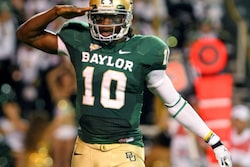JUST NOW: How Robert Griffin III has single-handedly changed Baylor’s national perception.. see more details 👇

1. The Player Who Turned Heads (2008–2011)
When RG III arrived on campus in January 2008 as a freshman quarterback, Baylor was a program in crisis—no bowl game in 17 years, a losing record that made them a punchline in the Big 12 . But Griffin, a multi-sport star who also thrived in track (even reaching NCAA finals in the 400-meter hurdles), didn’t just play—he performed. By the end of his freshman year, he had earned Big 12 Offensive Freshman of the Year honors .
That performance suggested promise—but Baylor’s national profile was still negligible. The narrative of a turnaround was just beginning.
—
2. The Heisman & National Attention (2011)
Griffin’s 2011 junior season was resurgent:
He threw for 4,293 yards and 37 TDs, and rushed for nearly 700 yards .
He led Baylor to a stunning 10–3 season, capped by a thrilling Alamo Bowl win—Baylor’s first bowl victory since 1992 .
Nationally, Griffin became the first Baylor player awarded the Heisman Trophy on December 10, 2011 .
One key week saw Baylor knock off TCU, prompting a jump from zero preseason votes to AP Top 20 status—a feat not seen since 1976 .
This season didn’t just bring accolades—it announced Baylor’s arrival. “This is a forever kind of moment,” Griffin exclaimed, foreshadowing the change .
—
3. A Branding Explosion
RG III’s impact went well beyond the field. Baylor literally rewrote its marketing playbook:
The athletic department launched an entire RG3 brand hub online and social media campaign—complete with #JoinTheThird Facebook names and #RG3pose Heisman poses submissions .
A year after his Heisman win, Baylor announced the Robert Griffin III Quarterback Scholarship, cementing his legacy and serving as both recruitment and brand strategy .
In 2013, his alma mater awarded him a Distinguished Achievement Medal, applauding his transformative effect on Baylor’s visibility—arguing he’d done more for the university brand than “anyone else ever has” .
—
4. Campus and Community Renaissance
RG III’s star helped catalyze infrastructure and cultural changes in Waco and at Baylor:
One Baylor staff member noted his presence helped birth McLane Stadium—a $266 million centerpiece that now defines the skyline and symbolizes football’s reemergence at Baylor .
Coach Art Briles later reflected that Baylor had “changed 100%” in football infrastructure, recruiting momentum, and campus atmosphere, crediting RG III as the spark .
The turnaround was tangible: Baylor went from the fringes of national relevance to repeat bowl teams, conference contenders, and a place “in the same conversation” as big-name programs .
—
5. The Tornado Effect on Reputation
Baylor’s perception nationwide shifted. Once a Big 12 joke—some fans even chanted “worse than Baylor”—by 2011, the program had credibility . One Reddit fan recalled:
> “RG3 is basically the main reason Baylor athletics is in the position it is in now. Suddenly Baylor became cool overnight because of him.”
Another remarked:
> “Without RG3 there is no modern Baylor. You cannot convince me otherwise.”
These sentiments echo the tangible shift in Baylor’s brand equity—from obscurity to national respect.
—
6. Off‑Field: Ambassadorial Excellence
Griffin was not just a star athlete—he was a textbook student-athlete:
He graduated in three years with a 3.67 GPA in political science and nearly finished a master’s .
Longtime Baylor media staff recalled how Griffin treated every reporter, every fan, and media person with respect, never walking away until all were satisfied—even after countless interviews .
His charity work, positive demeanor, and public persona made him the most marketable Baylor athlete ever, resonating in the Rhodes of sports communicators .
This kind of ambassadorial presence boosted Baylor’s profile across social media—his million‑plus Twitter followers alone ensured Baylor was part of broad national conversations .
—
7. Lingering Influence Beyond Graduation
RG III’s legacy didn’t fade with his departure:
Baylor has since added five more double-digit win seasons, three conference championships, and boasts the post‑RG III McLane Stadium .
Baylor marketing efforts have been structured around his model—combining performance, brand savvy, and community engagement.
His success also nurtured future recruiting. The aura he created—representing academic commitment, athletic excellence, and media-friendly charisma—continued attracting talent and fans alike .
—
8. A Mythic Archetype, Personified
Griffin wasn’t just another star QB—he was a phenomenon:
As a college QB with 3,000 passing yards AND 800 rushing yards, he joined only a tiny elite .
His pro trajectory reinforced Baylor’s rep—drafted No. 2 in 2012, becoming NFL Offensive Rookie of the Year and a Pro-Bowler .
Even today, his voice resonates—not just in replaying Baylor sports, but as a national broadcaster praised for his insight and charisma .
—
Final Assessment
Robert Griffin III’s impact on Baylor was multidimensional:
On-field excellence re-established Baylor as a national football power.
Off-the-field integrity and brand awareness elevated Baylor’s image across media and recruiting.
Infrastructure and investment blossomed—new stadium, scholarships, expanded reach.
Cultural shift: Baylor became “cool,” competitive, and credible.
Lasting legacy: Baylor now consistently competes at a higher level—matters of program, facilities, and profile owe more than a nod to RG III’s impact.
As BaylorProud put it: RG III’s Heisman season stands as a historic “before and after”—a moment when Baylor “became a household name far beyond the Baylor family” . In every meaningful metric—performance, image, perception—Robert Griffin III quite literally changed Baylor’s national perception—and his presence built a new Baylor.
—
Would you like to explore how Baylor maintained momentum post-RG3, or any other specific angle?
